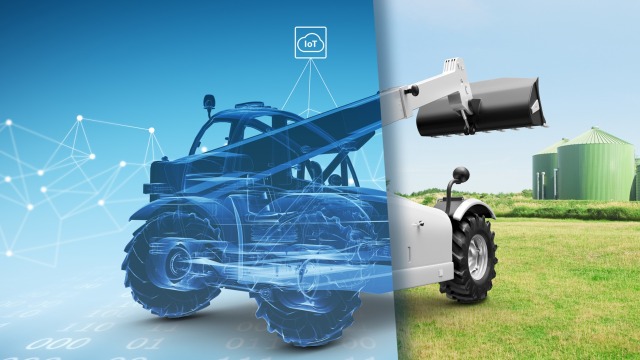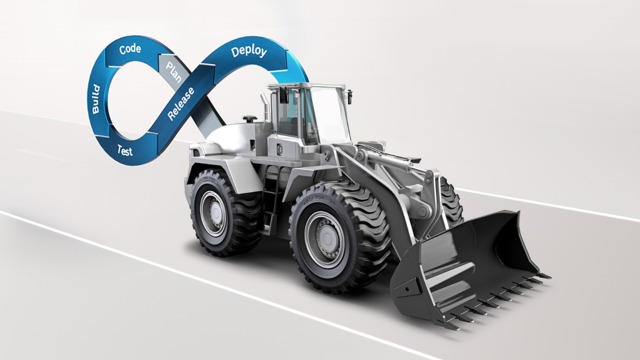



In the future, there will be two versions of each mobile working machine: one in the real world – and one in the digital world. One of those machines will work on construction and farming sites. The other will exist in the cloud.
“So-called digital twins offer Bosch Rexroth and its customers the opportunity to open up new areas of business,” says Christian Grabe, who is Business Owner Digital Business Mobile Hydraulics at Bosch Rexroth in Stuttgart. One of his teams focuses on connected digital twins. “Our goal is to position Bosch Rexroth as a provider and enabler of digital services and strengthen our expertise in data-driven product and service development.”

“The digital twin offers the opportunity to open up new business areas,” says Business Owner Christian Grabe.
Connectivity is already a key driver of development in the construction, agriculture, and material handling industry today. At its heart is the software-defined machine. Like with a smartphone, the goal is to keep improving it through updates. That way, people will be able to download new digital applications and functions remotely. Data from connected vehicles will also provide both OEM design departments and Bosch Rexroth insights for developing the next generation of hardware and will help to tailor the digital services precisely to their customers’ needs.
“Our BODAS Connect infrastructure for telematics in the off-highway industries builds a bridge to connect the depths of a machine’s control units with the digital twin in the cloud,” Grabe says. One key component is the data client, a software module that is used on all BODAS connectivity units. The data client records essential information from the control units within the vehicle, processes it to reduce data volume, and transmits it to the cloud. This way, the digital twin in the cloud is truly connected in real-time to its counterpart in the real world. This connection goes both ways: Thanks to the Over-the-air (xOTA) services within BODAS Connect, data can be transferred back into the vehicle in the form of new configurations and software. The result is a closed loop of data – something that offers new ways of developing algorithms and testing them during vehicle use without adversely affecting the rest of the system.
“We can use the cloud to combine data from a vehicle’s development, production, and operation,” explains Grabe the decisive advantage. Intelligently combining the data creates the digital twin, which can, for example, be deployed to show how the vehicle is being used or how much wear and tear individual components are being subjected to.

Data from real operations: the connected digital twin is designed to facilitate the improvement of hardware and software.

Michael Sturm
To help develop the digital twin, the team is banking on the strengths of various different Bosch divisions as well as intensive external partnering. “The combination of our knowledge across various domains and hardware components with the possibilities of the software-defined machine has the potential to create added value for everyone, from Bosch Rexroth itself to off-highway OEMs, their dealer network, other ecosystem partners – and all the way through to the end customer like rental and construction companies,” says Michael Sturm Head of IoT Sales for Bosch Rexroth’s telematics and IoT portfolio BODAS Connect. “Working together across many skilled partners in the ecosystem and with a focus on the customer is a key advantage to seizing this potential.”
One purpose of the connected digital twin is to make life easier for development departments by allowing them to improve hardware and software on the basis of real-world machine data. The approach provides information from connected construction, agriculture, and material handling vehicles on aspects such as machine use, enabling developers to optimize future product generations. This especially becomes vital for the ongoing development of new fully battery electric off-highway machines where OEMs break new ground.
“Detailed machine work recordings together with the ability to change software parameters within all domain controllers or even flash new software within entire pre- and post-SOP fleets becomes the new cutting edge for many OEMs,” says Grabe. He also notes that “for many players, this paves the path for feature-on-demand business models that we currently deploy alongside the rather engineering driven xOTA features.”

His sales colleague Michael Sturm underlines this point: “Some may still see feature-on-demand as a playground, where possibilities are simply explored. In the off-highway industries, however, there is a real business driven demand. Just one example: Instead of maintaining a highly diversified fleet in order to serve the different customer requirements, aerial work platform and scissor lift rental companies can substantially save on equipment cost and logistics by only investing in one type of vehicle – the one with the maximum lift height. With feature-on-demand, which is based on the connected digital twin infrastructure, they can release and charge the elevation based on the individual customer demand.”
The BODAS ecosystem from Bosch Rexroth offers off-highway players quick and easy access to greater productivity, efficiency and automation. The portfolio of Bosch Rexroth Digital Application Solutions ranges from IoT solutions, software and electronics hardware to the IoT infrastructure which is offered on a joint basis with Bosch. With its future-proof solutions, BODAS is a market leader when it comes to practicality and quality. As a complete offering, BODAS combines the company’s competence and application experience in a number of key areas, namely mobile hydraulics and electronics, edge analytics and the Internet of Things. This applies to standard products as well as individual solutions that are jointly developed with the OEMs.